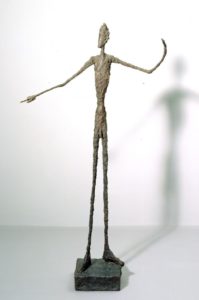01 June 2017
Giacometti
at Tate Modern (10 May – 10 September).
Reviewed by William Morton

When one thinks of Alberto Giacometti (1901-1966), the image most likely to come to mind is one of his attenuated male or female statues. However, these were produced at quite a late stage in his career when he had been a successful artist for many years.
He was born in Switzerland, the son of a moderately well-known painter, Giovanni Giacometti. After attending art school in Geneva, he moved to Paris and remained there for the rest of his life, apart from the period from the fall of France until the end of the Second War when he was unable to return after a visit to Switzerland and had to remain in Geneva.
His work reflects many influences including Egyptian and African art, Cubism and the Surrealism movement with which he was deeply involved. Sometimes, in his early career, he turned to design and a fine example of this in the exhibition is a stylised seagull. He did not go in for monumental sculptures and some on show are very small. Giacometti’s brilliance is his ability to convey the essence of something from a virtually featureless sculpture such as a minute one of a man with his hands in his pockets. Another, Man and Woman, gives a clear impression of sex with the merest hint at human bodies. Many of his sculptures could be grotesque, so far do they stray from reality, yet they are not.
Giacometti tended to use members of his family and a few close friends as models, who were required to endure long sittings. He had a slightly problematic brother called Diego, who became his studio assistant and an artist in his own right. Giacometti’s wife Annette and Diego were the subject of a large number of works. In a film shown in the exhibition, the artist says that he felt no need for a greater range of models as he had difficulty in tying down any person. One cannot help feeling that he must have had some idea of the characters of his wife and brother.
He was a fine draughtsman and an accomplished painter as well as a sculptor. In his pictures, he has the same ability to convey an image with a minimum of detail – except, I found, in a number of paintings of Diego, Annette and his mistress, Caroline. These seemed to me to lack a human spark and to convey little of the sitter.
It is, however, Giacometti’s stylised sculptures such as the Chariot (an example of which was sold in 2014 for 100 million dollars), the Running Man and that of a Hand which are his masterpieces and which stick in the mind.
If you enjoyed this article please share it using the buttons above.
Please click here if you would like a weekly email on publication of the ShawSheet

